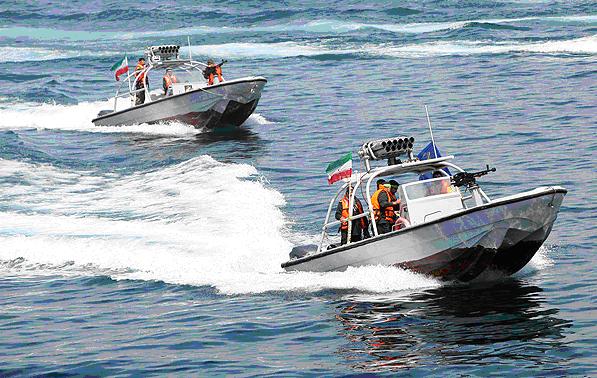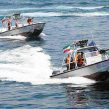
Iranian Naval Exercises Display Advancements in IRGC Armed Capabilities
By:

On April 22, the Iranian armed forces began an annual series of military exercises over the course of three days in the strategic Strait of Hormuz region (The Great Prophet 5) (IRNA, April 23; Press TV, April 23; Mehr, April 23; Keyhan, April 23). Named Payambar-e Azam 5 and carried out primarily by the naval forces of the Islamic Revolutionary Guard Corps (IRGC), the latest war games showcased the Guard’s latest advancements in military technology (IRNA, April 24; Press TV, April 24). The exercises featured dozens of speedboats attacking target ships with rockets and newly built torpedoes. Iran also claimed to have introduced a sonar-proof, remote-controlled speedboat called "Ya Mahdi” (Press TV, April 24). The presumed prototype allegedly deploys “high-intensity rockets,” though no further details were released and independent confirmation remains unavailable.
The IRGC claims the drills were displayed to show how Iran has become one of the strongest military powers in the world (Fars News, April 25). However, Iran typically exaggerates its naval strength, reclassifying supply ships as “battleships” and small frigates as “destroyers.” In reality, Iran has no capital ships and has nothing on active service larger than a frigate (see Terrorism Monitor, October 1, 2009). The near impossibility of obtaining capital ships under the sanctions regime appears to be behind Iran’s focus on innovative naval tactics based on small craft.
The latest military games show the extent to which Iran has expanded its capabilities by manufacturing its own military weapons. Although most of this month’s drill was naval in nature, the IRGC, which controls much of Iran’s most sensitive military technology, has in recent years developed a major air-based ballistic missile complex, along with anti-ship cruise missiles (Keyhan, March 12; Iran Times, April 23). The origin of Iran’s military technology program can be traced back to the years following the Iran-Iraq war (1980-1988), when various surface-to-sea and surface-to-surface missiles (with Shahab 3 as the most advanced type) were built by the IRGC with Russian assistance (IRNA, September 28, 2009; Fars, September 22, 2007). The new generation of smart bombs and cruise missiles with short and mid-range capabilities (such as the Sajil, Ghased-1, Ghadr and Nasr-1) introduced a new phase in the IRGC’s missile industry (Fars News, March 7; Keyhan, March 12). This program underlined the fact that Iran’s armed forces had shifted focus to a possible ground-based U.S.-led assault across the Afghan or Iraqi borders. In light of Iran’s weak air force, largely dependent on 1970s vintage warplanes, the Iranian response to a ground attack would require a series of missile counter-assaults on the enemy’s ground and air forces.
The recent introduction of unmanned surveillance aircraft and the February launch of a satellite have added a new intelligence collection asset to the IRGC’s abilities (Keyhan, March 19; Raja, April 25; Fars News, April 25). Such developments underline an increasing shift toward a new military policy, that is, the advancement of “soft war” tactics in a way to counter U.S. and Israeli intelligence measures (Fars News, April 24). [1] In another strategic move, the naval war games also hint at possible preemptive measures to cut off not only the 40 % of the world’s seaborne oil supplies that pass through the Hormuz Strait, but also the military supply chain that links U.S. forces based in Bahrain, the northern regions of the Persian Gulf, the Gulf of Oman and the northern Arabian Sea (Press TV, April 22). For the most part, the IRGC’s military capabilities are expanding on both tactical and strategic levels, including counter-intelligence activities, conventional warfare and asymmetrical warfare.
Tehran maintains a security strategy aimed at deterring potential U.S. or Israeli attacks on its territory–particularly its nuclear facilities—while strengthening its regional power through the expansion of its military capabilities. The latest military exercise, therefore, was not only meant to show the United States how Iran can protect its territory with modern military technologies, especially in a volatile and strategic region like the Hormuz Strait, but also to reinforce the perception of Iran as a regional power among the Gulf Cooperation Council nations (GCC). [2] In many ways, Iranians know that a military assault, particularly in the post-conflict phase after an invasion, would be a daunting task for the United States. They also know any sort of military aggression would ultimately require the logistical support of Iraq and the GCC states to allow the U.S. Air Force to operate.
The latest military games thus serve as a warning to the Arab states against providing support to the United States, reducing the chance of an American attack from the Persian Gulf coastline. Seen in this way, it is not surprising to see the IRGC invite military representatives of Qatar to the war games (Fars News, April 24; al-Manar TV, April 24). The key here is to understand not just how Iranians perceive the threat of an American or Israeli attack, but the way they see the perilous possibility of regional support for such an assault.
Furthermore, the Payambar-e Azam 5 exercises are not merely used by the state to thwart possible external threats, but also to propagate its military power for an audience at home. In a significant way, the Islamic Republic, which continues to undergo a crisis of legitimacy since the 2009 presidential elections, hopes to regain its authority by displaying how it can protect the country and hence consolidate power.
Notes:
1. The concept of “Soft War” has been much discussed in Iranian military and political circles. A Soft War, according to an Iranian news agency, is “a set of deliberately hostile acts aimed at transforming the fundamental cultural values and identities of a society. This type of war can influence all social aspects of a political system, and can include such phenomena as ‘cultural invasions’ and ‘psychological operations.’” (ISNA, March 31).
2. The GCC is composed of Bahrain, Kuwait, Qatar, Saudi Arabia, Oman, and the United Arab Emirates.





